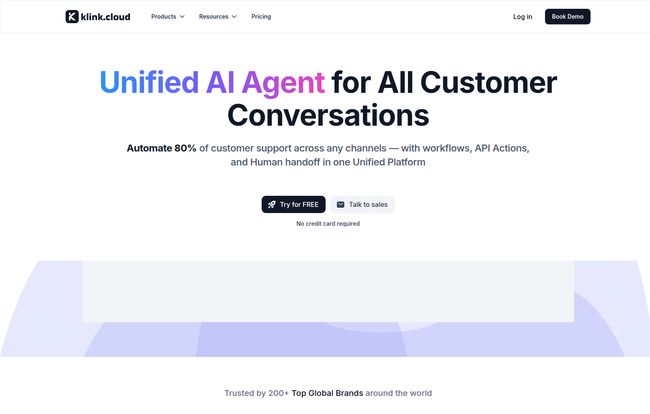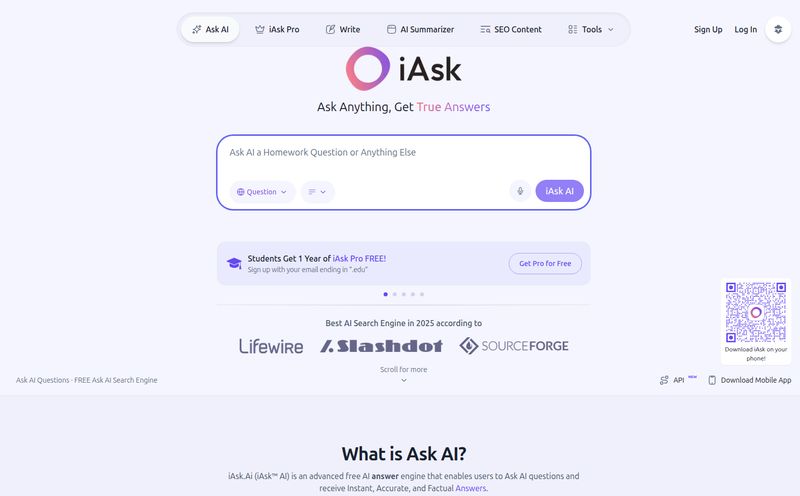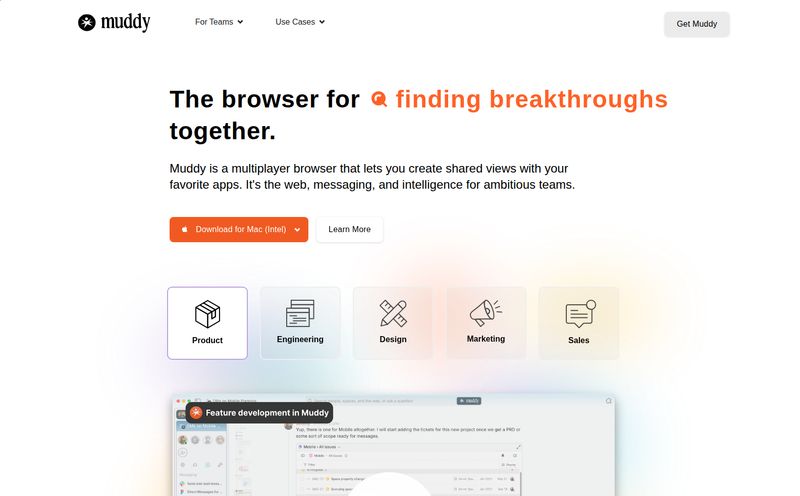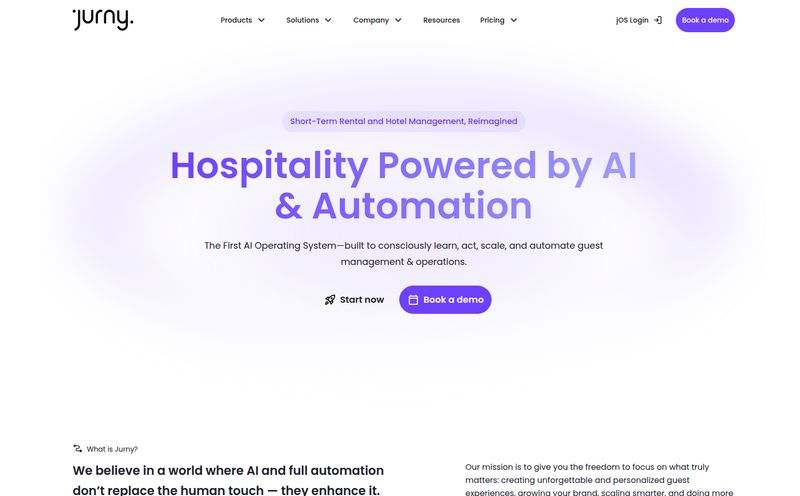If you're in any kind of business that talks to customers, your screen probably looks like a chaotic mosaic of tabs. You’ve got a customer DM on Instagram, an urgent email from a VIP client, and a live chat pinging insistently. All while your phone is buzzing with a call you probably should have answered ten minutes ago. It's organized chaos at best, and a one-way ticket to burnout at worst.
For years, we've been promised a magic bullet. A single platform to rule them all. The term "omnichannel" has been thrown around in marketing meetings so much it's almost lost all meaning. But every now and then, a tool pops up that makes me, a jaded old SEO and traffic guy, sit up and pay attention. Today, that tool is klink.cloud.
They’re making some big promises—automating 80% of support, unifying every conversation, and using AI to do the heavy lifting. So, is it just more marketing fluff, or have they actually cracked the code? Let's get into it.
What is klink.cloud, Exactly? The 30,000-Foot View
At its heart, klink.cloud is an omnichannel customer engagement platform. Think of it less as a single tool and more as a central nervous system for your business's communications. The whole idea is to stop the frantic tab-switching. Instead of logging into your email, then Facebook, then your phone system, you have one central hub.
It pulls in your voice calls, in-app chats, social media messages, emails, and SMS into one unified stream. It’s like Grand Central Station for your customer queries, but instead of chaos, there's an AI-powered conductor making sure every train gets to the right platform on time. That’s the dream anyway.
The Features That Actually Matter (No Fluff Allowed)
A shiny features list is nice, but I care about what actually moves the needle. After poking around klink.cloud, a few things really stand out as genuinely useful for day-to-day operations.
The Unified Inbox: Your Command Center for Sanity
This is the core of the whole operation. The unified inbox is exactly what it sounds like: one place to see and respond to everything. A customer could email you, then message you on WhatsApp a day later, and klink.cloud stitches that conversation together. For your support agents, this is huge. No more asking, "Have you contacted us before?" because they can see the entire history, right there, regardless of channel. It transforms the customer experience from a series of disjointed chats into one continuous conversation.
AI and Automation: The "Magic" Behind the Curtain
Okay, here’s where the big claims come in. klink.cloud is built around its Unified AI Agent. The promise? To automate up to 80% of customer support inquiries. That's a bold claim, one that I'm naturally skeptical of. But the way they approach it is interesting.

Visit klink.cloud
It's not just about basic chatbots that can answer "What are your hours?" The AI can handle more complex workflows. It can check an order status by integrating with your backend system, route a highly technical question directly to a senior engineer, or even summarize a long, rambling phone call into a few neat bullet points for your records. This is the kind of automation that doesn't just deflect tickets; it genuinely frees up your human team to handle the high-touch, high-value interactions. This is probably the biggest selling point of the whole platform.
Case Management and Analytics: Knowing is Half the Battle
If you can't measure it, you can't improve it. I’ve been saying that for years. klink.cloud’s Case Management feature is a godsend for managers. Every single customer issue, from the first touchpoint to the final resolution, is tracked as a single case. You get a full, chronological view of what happened, who handled it, and how long it took.
Combine that with their real-time analytics and you've got a powerful strategic tool. You can see which channels are busiest, what the most common problems are, and how your team is performing. This isn't just about putting out fires; it’s about finding the source of the smoke and fixing it for good.
Let's Talk Turkey: klink.cloud Pricing
Alright, the all-important question: how much does this cost? I was pleasantly surprised to see they have a very clear pricing structure, including a free tier. So many companies hide this behind a "Contact Sales" button.
| Plan | Price | Best For |
|---|---|---|
| Free | $0 / month | Individuals or solopreneurs just needing an outbound dialer and basic live chat. A great way to test the waters. |
| Starter | $19 / user / mo | Small teams. This plan unlocks the key channels like WhatsApp and social media, making it a true omnichannel starting point. |
| Growth | $55 / user / mo | Growing teams with higher volumes. You get the advanced AI features, serious automation, and deeper analytics here. This feels like their main offering. |
| Enterprise | Custom | Large corporations needing custom integrations, advanced security, and dedicated support. |
In my book, any platform that gives you a genuine free starting point gets a thumbs up. It shows confidence in the product. The jump from Starter to Growth is significant, but it's also where you unlock the most powerful AI capabilities, which is the platform's main differentiator.
My Honest Take on klink.cloud
So, after all that, what's the verdict? No tool is perfect, and it's always a balance of the good and the, well, not-so-good.
What I Genuinely Like
The unified platform concept is executed really well. It’s not just a collection of features, it feels like a cohesive system designed to solve the very specific pain of communication overload. The potential of the AI is also undeniable. If it can deliver on even half of its automation promise, the ROI is massive. I also appreciate the flexibility with telephony—letting you get a virtual number or connect your own SIP Trunks (BYOC) shows they understand that businesses have existing infrastructure. And that Free plan? Chef's kiss.
Where It Could Improve
While the pricing is mostly transparent, the classic "Contact Sales" for the Enterprise plan is always a bit of a pet peeve of mine. I get why they do it, but it adds a layer of friction. Also, their website, while slick, is very heavy on marketing language. It can take a bit of clicking around to find the nitty-gritty feature details buried in the comparison tables. Not a deal-breaker, but something to be aware of.
So, Who is klink.cloud Actually For?
This isn't a tool for the hobbyist blogger who gets a few comments a week. This is for businesses where customer communication is a core operational function. I see it being a perfect fit for:
- E-commerce Stores: Managing queries about orders, shipping, and returns across email, chat, and social media.
- SaaS Companies: Providing technical support and onboarding help through in-app chat, email, and scheduled calls.
- Service-Based Businesses: Think agencies, consultants, or even local services that need to manage appointments and client questions efficiently.
- Any growing team that feels like they're drowning in notifications and losing track of customer conversations. If you've ever said "Did anyone get back to that person on Facebook?", this is probably for you.
Final Thoughts
Look, the quest for the perfect, all-in-one customer communication platform is the holy grail for a lot of businesses. klink.cloud makes a very, very compelling case that they're closer than most. By centering their entire platform around a unified inbox and powerful, accessible AI, they're not just adding another tool to your stack—they're aiming to replace a whole mess of them.
It’s an ambitious goal, but from what I've seen, it's one they're well-equipped to tackle. If you're feeling the pain of customer communication chaos, I'd say giving their free or starter plan a try is a no-brainer. You might just find the peace and quiet you've been looking for.
Frequently Asked Questions
- Is the klink.cloud free plan really free forever?
- Yes, based on their pricing page, the Free plan is $0 per month. It's designed for individuals and has limitations (e.g., focused on outbound dialer and live chat), but it's a great way to experience the platform's basic functionality without any cost.
- What kind of tools does klink.cloud integrate with?
- They integrate with a ton of popular business systems. The website shows logos for major players like Salesforce and Zendesk, which is crucial for syncing customer data and creating a single source of truth across your tech stack.
- How does the AI automation actually work?
- It's a combination of things. It uses Natural Language Processing (NLP) to understand what a customer is asking for, then uses workflows you define to take action. This could be answering a question, routing the chat to a specific department, or creating a support ticket in an integrated system like Zendesk. The most advanced features are in the Growth and Enterprise plans.
- Can I use my existing business phone number with klink.cloud?
- Yes, the platform offers what's called "Bring Your Own Carrier" (BYOC) through SIP Trunking. This is a more technical feature, but it essentially means you can connect your existing telephony system and numbers to their platform, which is a huge plus for established businesses.
- Is klink.cloud difficult to set up?
- While any powerful platform has a learning curve, the tiered structure suggests it's scalable. The Starter plan seems designed for small teams to get up and running quickly. For the Enterprise plan with custom API integrations, you'd likely rely on their support and onboarding team for a more guided setup.



